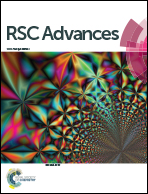Antifungal properties of nanosized ZnS particles synthesised by sonochemical precipitation
Abstract
Zinc sulphide (ZnS) nanoparticles, synthesised by a sonochemical route employing zinc chloride and sodium sulphide, displayed significant antifungal properties against the pathogenic yeast Candida albicans (MTCC 227) at a minimum fungicidal concentration of 300 μg ml−1. The antifungal properties of zinc sulphide particles is attributed to the generation of reactive oxygen species due to the interaction of the nanoparticles with water. Additionally, the presence of Zn in the zone of inhibition and the absence of antifungal effects for large micron sized particles of ZnS suggest a size induced effect leading to perturbation of fungal cell membranes, resulting in growth inhibition.


 Please wait while we load your content...
Please wait while we load your content...